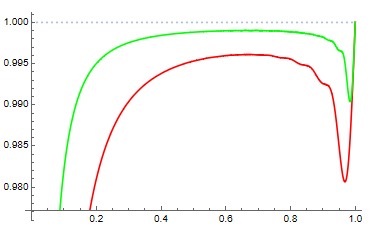Let $$J_{f;y}(u):=3 u^3 \int_u^1\frac{dt}{t^4} \,e^{-i y t}f(t)- e^{-i u y}f(u),$$ where $y\in(0,\infty)$, $u\in(0,1)$, and $$f(t):=t+\pi (1-t) t \cot (\pi t).$$
Here are the graphs of $f$ (black), $|J_{f;100}|$ (red), and $|J_{f;200}|$ (green):
and of $1$ (dotted), $|J_{f;100}|/f$ (red), and $|J_{f;200}|/f$ (green):
(The values of $J_{f;y}(u)$ for all the graphs here were obtained by non-controlled numerical integration using Mathematica's command NIntegrate[].)
It appears that $|J_{f;y}|$ is monotonically increasing in $y>0$ to $f$ (that $|J_{f;y}(u)|\to f(u)$ for each $u\in(0,1)$ as $y\to\infty$ follows by the Riemann–Lebesgue lemma).
Similar pictures obtain if $f(t)$ is replaced by $g(t):= \dfrac{\sin (2 \pi t)}{2 \pi }+\dfrac{1}{3} (1-t) (\cos (2 \pi t)+2)$.
Conjecture: $|J_{f;y}|\le f$ on $(0,1)$ for all real $y>0$.
Question: Is this conjecture true?
Here are also the plots $P(u_1,Y_1)$ (top), $P(u_2,Y_2)$ (middle), and $P(u_3,Y_3)$ (bottom), where $$P(u,Y):=\Big\{\frac{J_{f;y}(u)}{-e^{-i u y}f(u)}\colon0<y<Y\Big\},$$ $(u_1,Y_1):=(\frac1{10},800)$, $(u_2,Y_2):=(\frac5{10},600)$, and $(u_3,Y_3):=(\frac9{10},400)$:
Comment: The functions $f$ and $g$ are decreasing on $(0,1)$, but the conjecture will not hold in general if $f$ is replaced by an arbitrary decreasing nonnegative function $h$ such that $h(1)=0$. It would be interesting to know conditions on functions $h$ such that $|J_{h;y}|\le h$ on $(0,1)$ for all real $y>0$ -- but that would be just a cherry on the cake. It is enough for me to know if the conjecture is true as stated, for the particular function $f$.



